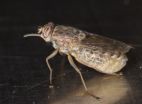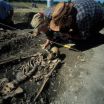(Press-News.org) New Haven, Conn. – An international team of researchers led by the Yale School of Public Health has successfully sequenced the genetic code of the tsetse fly, opening the door to scientific breakthroughs that could reduce or end the scourge of African sleeping sickness in sub-Saharan Africa. The study is published in the journal Science.
It took nearly 10 years and more than 140 scientists from numerous countries to map the genome of the fly, also known as Glossina morsitans. Tsetse flies are the sole insect vectors of a disease that threatens the health of millions of people and devastates livestock herds.
The genetic blueprint will provide researchers with the codes for the proteins that make up the tsetse fly, which is slightly larger than a common housefly. It is essentially a "parts list" of what the organism is made from. Access to the blueprint is expected to accelerate research into the tsetse fly's unique biology and promote the development of improved tsetse control methods as well as the development of new control strategies.
"This is a major milestone for the tsetse research community," said Geoffrey M. Attardo, a research scientist at the Yale School of Public Health and the paper's lead author. "Our hope is that this resource will facilitate functional research and be an ongoing contribution to the vector biology community." The effort has already resulted in eight research articles that expand on the genome data using functional genomics methods and
are being published under the banner "Tsetse Genome Biology Collection" in the PLOS-wide journals.
While there are drugs to combat sleeping sickness, they are expensive, have many undesirable side effects, and are difficult to administer in wide swaths of rural Africa where the disease is most pronounced. Left untreated, sleeping sickness is 100% fatal.
The researchers had to overcome numerous challenges — technical, biological and economic — in order to decipher the complete sequence. As with most genome projects the researchers had to limit their analysis to a single genetic line in order to improve the assembly of small fragments of sequence data — thousands of letters of code — into large scaffolds that contain millions of letters of code. This became an issue because only a small amount of genetic material is obtainable from each fly, and unlike other insects, one tsetse female gives birth to very few offspring. The genome contains approximately 366 million letters of code, which is equivalent to about 10% of those in the human genome.
School of Public Health professor Serap Aksoy helped initiate the collaborative research project in the early 2000s when she and a small group of other researchers concluded that progress against the disease and new tsetse-based control opportunities would be stymied unless the biological and chemical underpinnings of the organism were completely understood. The consortium was initiated with seed funding from the World Health Organization. "We are very happy to finally reach the finish line," Aksoy said. "Our hope is that tsetse research will now enjoy broader participation from the vector community and lead to improved and novel methods to eliminate disease."
INFORMATION:
The tsetse fly project cost approximately $10 million and was funded over the years from multiple public and private sources, including the WellcomeTrust, the World Health Organization Special Programme for Research and Training in Tropical Diseases, and the Ambrose Monell Foundation. The genome was sequenced and assembled at the Wellcome Trust Sanger Institute.
Data from the project is currently being hosted by Vectorbase and is publicly available for download or for direct analysis on the website using a comprehensive set of browsing, search and analysis tools.
In addition to Attardo and Aksoy, other Yale researchers involved in the project include Joshua Benoit, Brian Weiss, Jingwen Wang, Uzma Alam, Corey Brelsfoard, Michelle Maltz, Xin Zhao, Aurelien Vigneron, Erich Tellaria, and Veronika Michalkova.
A scourge of rural Africa, the tsetse fly is genetically deciphered
2014-04-24
ELSE PRESS RELEASES FROM THIS DATE:
Breakthrough harnesses light for controlled chemical reaction
2014-04-24
MADISON – When chemist Tehshik Yoon looks out his office window, he sees a source of energy to drive chemical reactions. Plants "learned" to synthesize chemicals with sunlight eons ago; Yoon came to the field a bit more recently.
But this week, in the journal Science, he and three collaborators detail a way to use sunlight and two catalysts to create molecules that are difficult to make with conventional techniques.
In chemistry, heat and ultraviolet (UV) light are commonly used to drive reactions. Although light can power reactions that heat cannot, UV has disadvantages, ...
Researchers build new 'off switch' to shut down neural activity
2014-04-24
Nearly a decade ago, the era of optogenetics was ushered in with the development of channelrhodopsins, light-activated ion channels that can, with the flick of a switch, instantaneously turn on neurons in which they are genetically expressed. What has lagged behind, however, is the ability to use light to inactivate neurons with an equal level of reliability and efficiency. Now, Howard Hughes Medical Institute (HHMI) scientists have used an analysis of channelrhodopsin's molecular structure to guide a series of genetic mutations to the ion channel that grant the power to ...
You may have billions and billions of good reasons for being unfit
2014-04-24
This news release is available in French. Although our chromosomes are relatively stable within our lifetimes, the genetic material found in our mitochondria is highly variable across individuals and may impact upon human health, say researchers at the University of Montreal and its affiliated CHU Sainte-Justine Hospital. Genomes are changing, not just from generation to generation, but even and in fact within our individual cells. The researchers are the first to identify the extent to which the editing processes of RNA code can vary across a large number of individuals. ...
Ocean microbes display remarkable genetic diversity
2014-04-24
CAMBRIDGE, Mass-- The smallest, most abundant marine microbe, Prochlorococcus, is a photosynthetic bacteria species essential to the marine ecosystem. An estimated billion billion billion of the single-cell creatures live in the oceans, forming the base of the marine food chain and occupying a range of ecological niches based on temperature, light and chemical preferences, and interactions with other species. But the full extent and characteristics of diversity within this single species remains a puzzle.
To probe this question, scientists in MIT's Department of Civil ...
Channel makeover bioengineered to switch off neurons
2014-04-24
Scientists have bioengineered, in neurons cultured from rats, an enhancement to a cutting edge technology that provides instant control over brain circuit activity with a flash of light. The research funded by the National Institutes of Health adds the same level of control over turning neurons off that, until now, had been limited to turning them on.
"What had been working through a weak pump can now work through a highly responsive channel with many orders of magnitude more impact on cell function," explained Karl Deisseroth, M.D., Ph.D., of Stanford University, Stanford, ...
Tsetse fly genome reveals weaknesses
2014-04-24
Mining the genome of the disease-transmitting tsetse fly, researchers have revealed the genetic adaptions that allow it to have such unique biology and transmit disease to both humans and animals.
The tsetse fly spreads the parasitic diseases human African trypanosomiasis, known as sleeping sickness, and Nagana that infect humans and animals respectively.
Throughout sub-Saharan Africa, 70 million people are currently at risk of deadly infection. Human African trypanosomiasis is on the World Health Organization's (WHO) list of neglected tropical diseases and since 2013 ...
Stanford team makes switching off cells with light as easy as switching them on
2014-04-24
STANFORD, Calif. — In 2005, a Stanford University scientist discovered how to switch brain cells on or off with light pulses by using special proteins from microbes to pass electrical current into neurons.
Since then, research teams around the world have used the technique that this scientist, Karl Deisseroth, MD, PhD, dubbed "optogenetics" to study not just brain cells but heart cells, stem cells and the vast array of cell types across biology that can be regulated by electrical signals — the movement of ions across cell membranes.
Optogenetics gave researchers a powerful ...
Cosmic illusion revealed
2014-04-24
This press release is available in Japanese.
Kashiwa Japan - A team of researchers led by Robert Quimby at the Kavli Institute for the Physics and Mathematics of the Universe (Kavli IPMU) has announced the discovery of a galaxy that magnified a background, Type Ia supernova thirtyfold through gravitational lensing. This is the first example of strong gravitational lensing of a supernova confirms the team's previous explanation for the unusual properties of this supernova.
The team has further shown how such discoveries of supernovae of Type Ia (SNIa) can be made far ...
Untangling Brazil's controversial new forest code
2014-04-24
Approved in 2012, Brazil's new Forest Code has few admirers. Agricultural interests argue that it threatens the livelihoods of farmers. Environmentalists counter that it imperils millions of hectares of forest, threatening to release the billions of tons of carbon they contain. A new study, co-authored by Woods Hole Research Center (WHRC) scientists Michael Coe, Marcia Macedo and Brazilian colleagues, published this week in Science, aims to clarify the new law. Entitled "Cracking Brazil's Forest Code," the article is the first to quantify the implications of recent changes ...
Genomic diversity and admixture differs for Stone-Age Scandinavian foragers and farmers
2014-04-24
An international team led by researchers at Uppsala University and Stockholm University reports a breakthrough on understanding the demographic history of Stone-Age humans. A genomic analysis of eleven Stone-Age human remains from Scandinavia revealed that expanding Stone-age farmers assimilated local hunter-gatherers and that the hunter-gatherers were historically in lower numbers than the farmers. The study is published today, ahead of print, in the journal Science.
The transition between a hunting-gathering lifestyle and a farming lifestyle has been debated for a century. ...




